
Understanding Our Church
A Treasury of Arkansas Writers Discussing the Catholic Faith
Official Website of the
Catholic Diocese of Little Rock
To call upon Mary as mother of God is to pay her honor
Published: September 25, 2004
By Charles T. Sullivan
“From the earliest times, the blessed virgin has been honored with the title ‘Mother of God,’ under whose protection the faithful take refuge …” (Vatican II, Dogmatic Constitution on the Church, 66)
The foremost revealed truth about Mary (a sort of “first principle” from which all her other roles and honors flow) is the fact that she is truly the mother of God. This truth, explicitly revealed in the Scriptures (Matt 1:18-25 or Luke 1:26-28), was solemnly defined at the Ecumenical Council at Ephesus in 431 A.D. when Mary officially received the title “Theotokos” or “God-bearer.”
Since the human nature of Jesus is inseparably united to his divine nature in the one person of Christ, it was reasoned, then, that Mary gave birth to a son who is truly God and, through the instrument of her own humanity, also truly man. Following Ephesus, the Councils of Chalcedon (451 A.D.), Constantinople II (553 A.D.), and Constantinople III (681 A.D.) supplied further clarifications and refinements to both the mystery of Christ’s incarnation as well as Mary’s most-fitting designation as mother of God.
Soon after the definitions of Ephesus, liturgical feasts honoring Mary began to appear in many places throughout Christendom. By the seventh century, the Church in Rome celebrated Mary’s divine motherhood as its primary Marian feast on the first day of each New Year. Over the course of many centuries, and because the Gospel read at the Mass on that day, the solemnity was transformed and renamed “the circumcision of Jesus.”
The new Roman Calendar of 1969 restored the liturgical celebration to its original meaning — a commemoration recognizing and venerating Mary as the mother of God. In this way, one of the most ancient of all the liturgical feasts has been reestablished in the Western Church.
At the close of the Second Vatican Council, a further consequence of Mary’s divine motherhood was brought to light when Pope Paul VI proclaimed her to be “mother of the Church.” The pope had received numerous requests from the council fathers to give special attention to the maternal role of Mary, and his official proclamation was received with near-unanimous approval.
This title, while not specifically mentioned in the promulgated documents of the council, is in continuity with other modern-era papal pronouncements and has firm basis in both sacred Scripture and the ancient traditions of the Church. As we think about Mary and her special place in God’s eternal plan of salvation, it is good to recall that Church doctrine concerning the mother of God is closely linked with (and always subordinate to) pronouncements about Christ.
“What the Catholic faith believes about Mary is based on what it believes about Christ, and what it teaches about Mary illumines in turn its faith in Christ.” (“Catechism of the Catholic Church,” 487) To call upon Mary as mother of God is to pay her the highest possible honor and is consistent with a living tradition in the Church that spans nearly 18 centuries.
Her title of “Theotokos” is a concrete expression of the central truth of our Catholic faith: Jesus Christ, savior of the world, is son of God and son of Mary.



